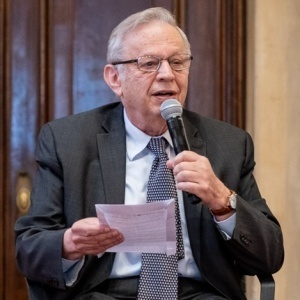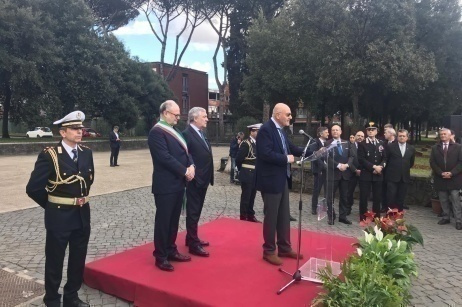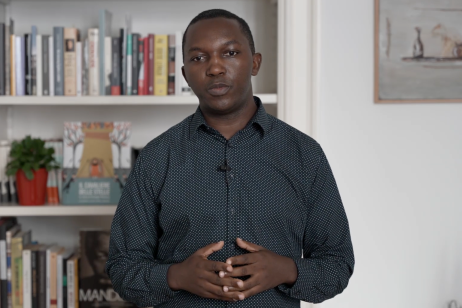
Oskar Schindler
In trying to analyze the motivations of rescuers of Jews during the Holocaust, studies of human behavior during normal times fall short of providing satisfactory explanations. Especially when one tries to draw altruistic analogies of rescue acts during the Holocaust with other humanitarian endeavors in more favorable and not so radically dangerous situations. Let us consider some of the contextual factors associated with people who helped Jews to survive, especially during the mass killing phase of the years 1941-1945, that place them in a special category, and sharply different from many other (though not all) altruistic behaviors in other settings
First of all, during the Holcaust, helping a Jew avoid arrest was a capital offense punishable by death, or at the best incarceration in a concentration camp. The rescuer’s family could also face retribution from the Nazis and their collaborators. Understandably, some people may have wanted to help but not at the price of losing their life and endangering the well being of their loved ones; their wives and children. When Mother Teresa decided to head to India in order to help out those needing assistance, it was not an undertaking forbidden by Indian laws, with the attending death penalty for those violating these laws. By contrast, the Holocaust rescuer was acutely aware that should his/her involvement in help to Jews be disclosed, it could cost the life of the rescuer. This fundamental distinction between these two forms of altruistic help should be kept in mind.
The second element to take into consideration is that the Holocaust rescuer did not choose this responsibility, after giving himself a comfortable time for some self-reflective rational thought. He did not say to himself, “I have decided that I want to go out and rescue the other. Rather, the other person has thrust himself upon me. He, or she, who perhaps knew me from before, or was referred to me by someone else, knocked on my door and asked for my help. That other person, a Jew on the run and wished to stay alive initiated the rescue attempt and hoped for my positive response to his plea.” Again, the difference with the story of Mother Teresa; she did not wait for persons in India to knock on her door and plead for help. She reflected on how best imparting a meaning to her life, and made a rational decision that this is what she wanted to dedicate herself to. It was not thrust on her. It does not in any way diminish from her heroic altruistic activity in India for many years, but just to point out the distinction between these two modes of decision making.
In addition, the the sense of one’s moral responsibility. When that other person showed up at the would-be rescuer’s door, he placed that person in a unique situation. Looking into his possible savior’s eyes, he awakened in him the realization that if he does not wish to get involved, then the Jew’s life, back in the cold, may come to a sudden end. During these short critical moments, the would-be rescuer may say to himself, “If I intervene, I will prolong his life; otherwise, it may be fatal for that person. The situation is such that I cannot hand over this responsibility to another person. As far as I know, there is no other alternative to my acting. In a certain sense my uniqueness, my individuality as actor or agent arises from this encounter in which I am, uniquely, called to respond.”
In the few seconds or minutes that the would-be rescuer has to respond, while the victimized person is staring at him, he becomes suddenly aware that the life of that other person is in his/her hands. He may reflect: “I have been thrust by that other person into the role of playing God. I can prolong that person’s life or shorten it by denying my hospitality. In fact, at this very moment, I am life for the other person. At this moment I am, for him, God.” A fleeting thought in the rescuer’s mind may also deal with the senselessness of what is happening to the Jews. Whether one likes Jews or not, there is no justification for the mass murder of Jews. It does not make sense. Who has given the Germans the right to decide who is entitled to live or die? The situation is so irrational that it cannot be integrated with the categories he has for making sense of his world. Furthermore, if that is the fate for Jews, maybe I, the non-Jew, may be next in line. In Poland, many feared that after the extermination of the Jews, it would be the turn of the Poles. If life is the foundation of all our human possibilities, to arbitrarily call life into question is to undermine the very possibility of this making sense, and therefore calls for a response—in favor of life as a fundamental principal of human existence.
The rescuer also realizes the uniqueness of his own irreplaceability. There is no one else for the Jew to turn to. This is particularly the case in eastern Europe, where rescue networks were far less common. The fact that the population was largely antisemitic also impeded the formation of such networks. In western Europe, by contrast, rescue networks did arise, especiall in the Netherlands, Belgium and France, where they also chose to help Jews on the run.
An additional factor is the need for an instantaneous response. To take in the Jew standing before you is not a matter of reflective thought (as it might be if you had been asked to help or received a letter and have time to weigh up the different options). A response, either way, is to be had immediately. Take the story of Chaya-Helena Elbojm-Dorembus, who smuggled herself and her family out of the Warsaw ghetto and lived for a time disguised as a Pole. She then approached a person who had known her in the past. She wrote: “When I walked into the small shack… Stach crossed himself as if he were seeing a ghost. His wife dropped a spoon she had been drying. “Jesus-Mary, you look terrible, Madam Helena!” Chaya: “Can I spend the night with you?” Stach: “What do you mean, spend the night? And what’ll you do tomorrow, Madam Helena? And where’s your husband, your mother, Hilda? The whole family?” Chaya: “Listen to me, Pan [Mister] Stach. I’m carrying around a death sentence with me, but I’ve no right to impose it on others. Tomorrow I’ll leave for one of the villages, maybe I’ll find work there. My husband’s still in the ghetto. My mother, my husband’s mother, my daughter—they’re no longer alive.” Stach buried his face in his hands and cried. “You’re staying with us,” he said after regaining his self-composure. “And I’ll take your husband in with us too. We are as dust at your feet, and if death strikes at you, let the devil take us too. Yes, I put my trust in the good Lord to protect us.”[1]
Also to bear in mind, during the Holocaust, the rescuer faced an open ended commitment, one that does not have a foreseeable ending. A person rushing into a burning building to save a child may also act nonreflectively, but he knows whether he succeeds or fails, his intervention has a terminus; the act will end in a few minutes. The rescuer of the Jew has no such preemptive assurance. The commitment made to rescue a Jew, may last days, months and even years. The rescuer is not even sure who will win the war. The end of the path he has chosen is open, without closure, while the risk of death is at least as great as in most heroic actions that involve a finite timeline commitment.
Students of social behavior teach us that most people usually view themselves as pursuing ethical modes of behavior, as dictated by the standards of the surrounding society. Following these standards as well as the group pressures which enforce them, most of the decisions we make are not necessarily individually prompted. By contrast, in the extraordinary circumstances of the Holocaust years, the rescuer’s decision to help out may not be in line with society’s code of behavior when involving Jews. In many European countries, antisemitic feelings ran deep among wide strata of the population, and society leaders held back from calling on people to assist Jews. On the contrary, in many cases, they urged people either to help the Germans round up Jews or at best turn a passive eye in the other direction. What one must constantly keep in mind is that the rescue action is taking in extraordinary circumstances, where’s societies centuries-old established values are turned upside down. Hence, the rescuer’s positive decision may not be socially imposed, and there may be no social reward for the act. . Helping Jews to stay alive meant disobeying the law; a misbehavior not to be tolerated under normal circumstances. Here, the decision is between the person and one’s self conscience. Since the deed is not socially acceptable, and the Holocaust rescuer is not of the typical heroic figure who is lauded by society, his/her deed must be kept secret, understandably during the war, but even after the war, to avoid society’s disapproval, and in some cases harm, of the rescuer’s action.
Therefore, in evaluating the role of the rescuer, a possible explanation could be the very fact of the nature of the encounter between rescuer and rescued, where both sides are in a face-to-face situation. In this context, the idea of the Other in the thinking of the French Jewish philosopher Emmanuel Levinas may be of help. As he explained, the proximity, the other person’s face in front of me is on a deeper level a reflection of a certain transcendent relationship with that other person, the stranger, and causes the other person’s face to become an “insider,” a part of my own Being. In non-philosophical terms, it may mean that every person has an inborn humanitarian disposition that is triggered, in a face-to-face situation with the Other (l’autrui in Levinas’ language) – the stranger. What happens then according to Levinas, is that in the presence of the other’s face, the dormant Other in me “is my standing outside myself, calling myself into question,” and viewing the mortality of that other person which I share, it evokes a reponse.
The Other, in Levinas’ explanation is an inborn attribute somehow present in me, in my sub-consciousness, yet not something that I can synthesize or represent to myself. This affects my behavior, since my grasp of myself necessarily includes a grasp of the Other who is “in” me. The Other, however, is “in” me as an other than me. I am never able to comprehend the Other, to encompass it, but he is at the same time the locus of my obligations. I am a self insofar as I carry the alterity of the Other in myself. Hence, the encounter with the other person makes possible the soul’s dialogue with itself. Given that the other is the source of my questioning, my answering is a responding to the Other in me.
A true ethics, according to Levinas, begins with intentionality, which is a turning towards and responding to the other, since I am only true to myself as long as I carry the other’s presence in myself. This encounter with the other makes possible a true self-dialogue with one’s conscience – the soul’s dialogue with itself. That takes place when I question myself in light of the other, who is somehow also present in me, in my consciousness, yet that particular person facing me is part of me only in the sense of the Other as an archetypal force (to use a a Jungian term) within me.
This apprehension of the Other necessitates a commitment, of caring for the other person’s needs, when such a necessity arises. This obligation is non-symmetric, in the sense that my help to the other person is not conditioned by a similar reciprocal obligation by the assisted person. According to Levinas, God as a transcendent Being is unapproachable, except through the encounter with another human being; an encounter which imposes an obligation upon one of the parties. This, according to Levinas, is the essence of a true religious life – the concern for other’s well-being occasioned by the face-to-face encounter.[2]
In this context, “ethics begins with the face of the other,” which includes a recognition and respect of the other’s selfhood or, in Levinas’ words, the other’s Alterity. According to Levinas, the face-to-face encounter is the beginning of a personal and authentic ethics which exists beyond every form of a socially-conditioned ethics. This ethical responsibility toward others should be the starting point and primary focus for philosophy rather than the search of one’s Being that has been the backbone of much of Western philosophy since Plato. In Levinas’ words, “ethics precedes ontology” (the study of Being). The search for one’s true Self is possible only with the recognition of the Other, a recognition that carries responsibility toward the other person.
Is it possible that what took place during the sudden encounter of a would-be rescuer and a fleeing Jew is explainable in terms of Levinas’ thoughts? That this proximity with someone facing you who desperately needs your help to stay alive, is what triggered the rescuer’s response? The help of a face-to-face encounter does not apply to those whose job was to persecute the helpless other, as that person has already been psychologically programmed by group and social pressure to divorce his behavior from one’s self-ingrained conscience, as demonstrated in the studies Stanley Milgram and Christopher Browning’s German police unit 101.
We have here in mind persons who had the freedom and flexibility of stepping forward and offer some form of help, with a large degree of success in that risky endeavor, and perhaps may also have had a deeper ingrained disposition in that direction, due to factors as explained by students of human behavior. Could this apply to the rescuers in our study? It is a tantalizing idea, worthy of serious consideration.
Let us remember that most rescuers when asked what prompted them to respond positively to the call for help find it hard to come up with reasonable explanations. None quote statements by the world’s great philosophers, but simply state that it was the most natural thing for them to do, to help out a fleeing Jew, or the Jew’s entire family. Is it possible that Levinas’ image of the Other in one’s subconscious makeup is what triggered the response, perhaps, with other dynamic forces having to do with one’s background?
The distinction between an ethics logically arrived at, as in the case of Mother Teresa, and one instinctively aroused, as with most Holocaust rescuers, shows itself in the fact that the event of rescue is not necessarily integrateable in the rescuer’s life. Schindler’s choice to rescue Jews had no effect on the alcoholism and womanizing and shady financial deals that marked his life. It is not something that necessarily changes a person’s life. It is based on an extraordinary set of circumstances, and may have been prompted by the senselessness of the situation that pushed them to a primal, precognitive level response, combined with a face-to-face encounter with one of the victims of that senseless situation. The rescuer’s act may not replicate itself; yet it remains a sui generis saintly act.
[1] Yisrael Gutman and Shmuel Krakowski, Unequal Victims: Poles and Jews During World War Two. New York: Holocaust Library, 1986, 197.
[2] For more by Levinas, see Emmanuel Levinas, Total and Infinity. Pittsburgh: Duquesne Uni., 1969; also: Alterity & Transcendence. London: Athlone, and New York: Columbia Uni., 1999. Also, Ze’ev Levy, “The Concept of ‘the Other’ in Levinas’ Ethics,” Daat (Hebrew) 30, 1993; 21-40; Elisabeth Goldwyn & Yoram Verta, “Toward the Other: Emmanuel Levinas,” Shadmot (Hebrew) 10, 1999.







